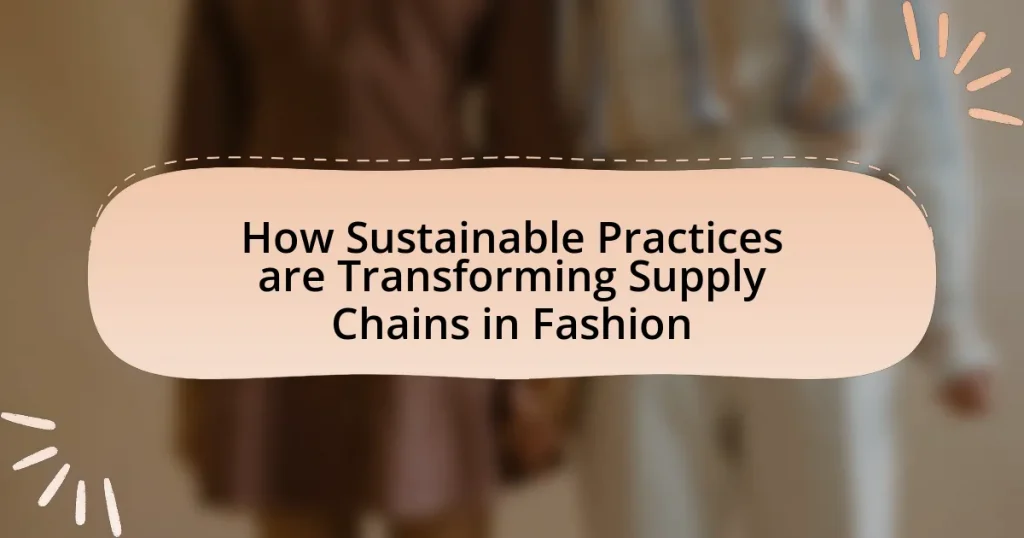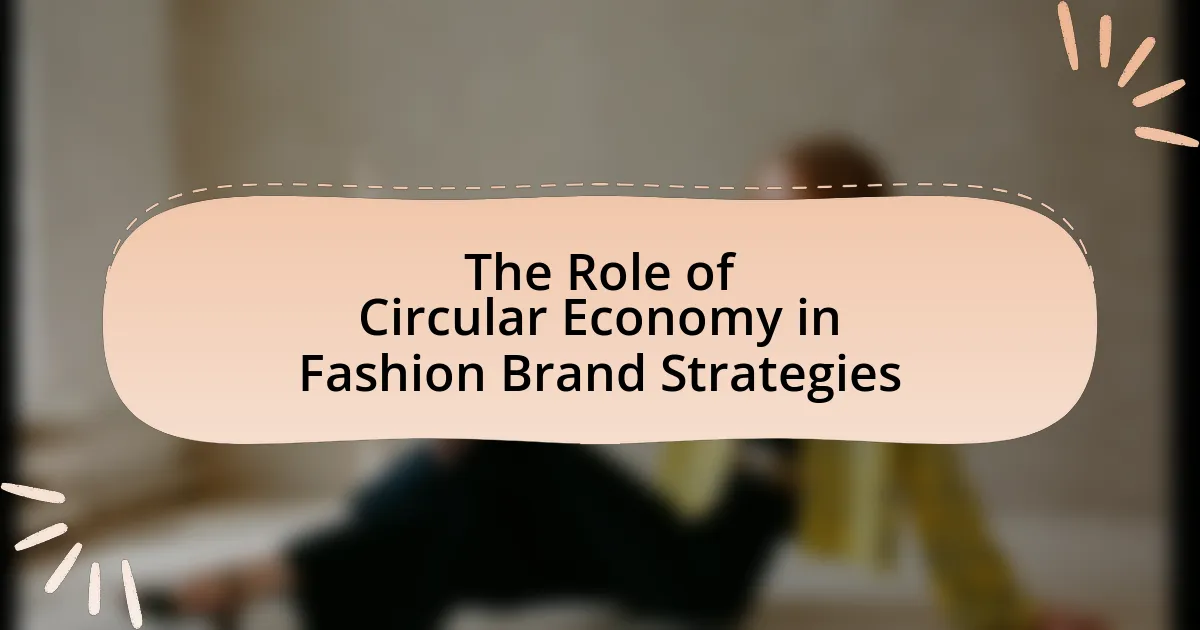The article examines how sustainable practices are transforming supply chains in the fashion industry. It highlights the integration of eco-friendly materials, waste reduction strategies, and ethical labor standards, driven by consumer demand for transparency and accountability. Key sustainable practices include the use of organic and recycled materials, circular fashion initiatives, and the implementation of technologies like blockchain and AI to enhance traceability and efficiency. The article also discusses the challenges brands face in adopting these practices, the economic benefits of sustainability, and emerging trends such as increased transparency and circular economy models. Overall, it underscores the importance of sustainability in addressing environmental and social issues within the fashion supply chain.

How are Sustainable Practices Changing the Fashion Supply Chain?
Sustainable practices are fundamentally altering the fashion supply chain by integrating eco-friendly materials, reducing waste, and promoting ethical labor standards. These changes are driven by consumer demand for transparency and accountability, leading brands to adopt practices such as circular fashion, which emphasizes recycling and reusing materials. For instance, a report by McKinsey & Company highlights that 67% of consumers consider sustainability when making a purchase, prompting brands to innovate in sourcing and production methods. Additionally, the implementation of technologies like blockchain enhances traceability, allowing consumers to verify the sustainability of products. This shift not only addresses environmental concerns but also aligns with regulatory pressures for more sustainable operations in the fashion industry.
What are the key sustainable practices being adopted in fashion supply chains?
Key sustainable practices being adopted in fashion supply chains include the use of eco-friendly materials, waste reduction strategies, and ethical labor practices. Eco-friendly materials, such as organic cotton and recycled polyester, reduce environmental impact by minimizing resource consumption and pollution. Waste reduction strategies, including circular fashion initiatives and upcycling, aim to decrease textile waste by promoting recycling and reusing materials. Ethical labor practices ensure fair wages and safe working conditions, addressing social sustainability alongside environmental concerns. These practices are increasingly supported by consumer demand for transparency and sustainability in the fashion industry.
How do these practices impact sourcing and materials used?
Sustainable practices significantly impact sourcing and materials used in the fashion industry by prioritizing eco-friendly and ethically sourced materials. These practices encourage brands to select organic cotton, recycled polyester, and other sustainable fibers, which reduce environmental harm and resource depletion. For instance, a report by the Global Fashion Agenda indicates that using recycled materials can lower greenhouse gas emissions by up to 30%. Additionally, sustainable sourcing often involves transparency in the supply chain, ensuring that materials are obtained from suppliers who adhere to ethical labor practices, thus promoting social responsibility alongside environmental sustainability.
What role does technology play in implementing sustainable practices?
Technology plays a crucial role in implementing sustainable practices by enabling efficient resource management and reducing waste in supply chains. For instance, advanced data analytics and artificial intelligence allow fashion companies to optimize inventory levels, minimizing overproduction and excess stock, which are significant contributors to environmental degradation. According to a report by McKinsey & Company, the use of digital tools can reduce supply chain emissions by up to 30% through improved logistics and production planning. Additionally, technologies such as blockchain enhance transparency, allowing consumers to trace the sustainability of materials used in their garments, thereby promoting ethical sourcing and production practices.
Why is sustainability important in the fashion industry?
Sustainability is important in the fashion industry because it addresses environmental degradation, social inequality, and economic viability. The fashion industry is one of the largest polluters globally, contributing to 10% of annual carbon emissions and significant water waste. By adopting sustainable practices, brands can reduce their ecological footprint, promote ethical labor practices, and ensure long-term profitability. For instance, the use of organic materials and recycling initiatives can decrease resource consumption and waste, aligning with consumer demand for environmentally responsible products.
What are the environmental impacts of traditional fashion supply chains?
Traditional fashion supply chains have significant environmental impacts, primarily due to high resource consumption and pollution. The production processes often involve extensive water usage, with the fashion industry accounting for approximately 20% of global wastewater. Additionally, the use of synthetic fibers, which are derived from petroleum, contributes to microplastic pollution in oceans, affecting marine ecosystems. Furthermore, traditional supply chains typically rely on fossil fuels for transportation, leading to substantial greenhouse gas emissions. According to the United Nations Environment Programme, the fashion industry is responsible for about 10% of global carbon emissions, highlighting its role in climate change. These factors collectively demonstrate the detrimental environmental effects associated with conventional fashion supply chains.
How does consumer demand influence sustainability in fashion?
Consumer demand significantly influences sustainability in fashion by driving brands to adopt eco-friendly practices and materials. As consumers increasingly prioritize sustainability, brands respond by integrating sustainable sourcing, reducing waste, and improving labor conditions. For instance, a 2021 McKinsey report indicated that 67% of consumers consider sustainability when making a purchase, prompting brands to innovate and offer sustainable options. This shift not only meets consumer expectations but also encourages a broader industry transformation towards sustainable practices, ultimately reducing the environmental impact of fashion production.
What challenges do fashion brands face in adopting sustainable practices?
Fashion brands face significant challenges in adopting sustainable practices, primarily due to high costs, supply chain complexities, and consumer demand for fast fashion. The transition to sustainable materials often requires substantial investment, which can deter brands from making the shift. Additionally, the existing supply chains are typically optimized for speed and cost, making it difficult to integrate sustainable practices without disrupting operations. Consumer preferences for low-cost, quickly available products further complicate this transition, as brands may fear losing market share if they prioritize sustainability over immediate profitability. According to a 2021 McKinsey report, 66% of consumers are willing to pay more for sustainable brands, yet the majority still prioritize price and convenience, illustrating the tension between sustainability and consumer behavior.
How do cost implications affect the transition to sustainable supply chains?
Cost implications significantly influence the transition to sustainable supply chains by determining the feasibility and speed of adopting eco-friendly practices. Companies often face higher initial investments for sustainable materials and technologies, which can deter them from making the switch. For instance, a study by McKinsey & Company found that transitioning to sustainable practices can increase costs by 10-20% in the short term, impacting profit margins. However, long-term savings and consumer demand for sustainable products can offset these costs, as evidenced by a Nielsen report indicating that 66% of global consumers are willing to pay more for sustainable brands. Thus, while cost implications present challenges, they also create opportunities for companies to innovate and align with market trends.
What are the barriers to collaboration among stakeholders in the supply chain?
Barriers to collaboration among stakeholders in the supply chain include lack of trust, differing objectives, and inadequate communication. Trust issues arise when stakeholders prioritize their own interests over collective goals, leading to reluctance in sharing information. Differing objectives can create conflicts, as each stakeholder may focus on their specific targets, such as cost reduction or sustainability, rather than aligning with the broader supply chain goals. Inadequate communication often results from technological gaps or cultural differences, hindering effective collaboration. These barriers can significantly impede the implementation of sustainable practices in fashion supply chains, as evidenced by studies showing that companies with strong collaborative frameworks achieve better sustainability outcomes.
How can fashion brands effectively measure sustainability in their supply chains?
Fashion brands can effectively measure sustainability in their supply chains by implementing comprehensive metrics that assess environmental impact, social responsibility, and economic viability. These metrics often include carbon footprint analysis, water usage assessments, waste management evaluations, and labor practices audits. For instance, the Global Reporting Initiative (GRI) provides standardized guidelines that help brands quantify their sustainability efforts, allowing for transparent reporting and benchmarking against industry standards. Additionally, tools like Life Cycle Assessment (LCA) enable brands to evaluate the environmental impacts of their products from raw material extraction to end-of-life disposal, providing a holistic view of sustainability. By utilizing these methodologies, fashion brands can not only track their sustainability performance but also identify areas for improvement and drive more responsible practices throughout their supply chains.
What metrics are used to assess sustainability performance?
Metrics used to assess sustainability performance include carbon footprint, water usage, waste generation, and social impact indicators. Carbon footprint measures greenhouse gas emissions, providing insight into environmental impact; for instance, the Global Carbon Project reported that global CO2 emissions reached 36.4 billion tons in 2019. Water usage metrics evaluate the volume of water consumed in production processes, with the World Resources Institute noting that the fashion industry accounts for 20% of global wastewater. Waste generation metrics track the amount of waste produced, highlighting the need for circular economy practices; the Ellen MacArthur Foundation estimated that 92 million tons of textile waste are generated annually. Social impact indicators assess labor practices and community effects, with the Ethical Trading Initiative emphasizing the importance of fair labor conditions in supply chains. These metrics collectively provide a comprehensive view of sustainability performance in the fashion industry.
How can brands report their sustainability efforts transparently?
Brands can report their sustainability efforts transparently by utilizing standardized reporting frameworks such as the Global Reporting Initiative (GRI) or the Sustainability Accounting Standards Board (SASB). These frameworks provide guidelines for measuring and disclosing environmental, social, and governance (ESG) performance, ensuring consistency and comparability across industries. For instance, a 2021 report by the GRI indicated that companies adhering to these standards are more likely to gain stakeholder trust and improve their sustainability performance. Additionally, brands can enhance transparency by publishing regular sustainability reports that detail specific metrics, goals, and progress, thereby allowing consumers and investors to assess their commitment to sustainable practices effectively.

What are the benefits of sustainable practices in fashion supply chains?
Sustainable practices in fashion supply chains lead to reduced environmental impact, improved brand reputation, and enhanced consumer loyalty. By implementing eco-friendly materials and processes, companies can significantly lower carbon emissions and waste, contributing to a healthier planet. For instance, a study by McKinsey & Company found that sustainable fashion practices could reduce greenhouse gas emissions by up to 30% by 2030. Additionally, brands that prioritize sustainability often experience increased customer trust and loyalty, as consumers are increasingly favoring companies that demonstrate social responsibility. This shift not only benefits the environment but also drives profitability and market competitiveness in the fashion industry.
How do sustainable practices enhance brand reputation?
Sustainable practices enhance brand reputation by demonstrating a commitment to environmental and social responsibility, which resonates with consumers. Brands that adopt sustainable practices often experience increased customer loyalty, as 66% of global consumers are willing to pay more for sustainable brands, according to a Nielsen report. This commitment not only attracts eco-conscious consumers but also fosters trust and credibility, as transparency in sourcing and production processes becomes a key differentiator in the competitive fashion industry. Furthermore, companies that prioritize sustainability can mitigate risks associated with regulatory compliance and supply chain disruptions, further solidifying their reputation as responsible market leaders.
What impact does sustainability have on customer loyalty?
Sustainability significantly enhances customer loyalty by aligning brand values with consumer expectations for ethical practices. Research indicates that 66% of global consumers are willing to pay more for sustainable brands, demonstrating a direct correlation between sustainable practices and increased customer retention. Brands that adopt sustainable practices often experience higher levels of trust and emotional connection with their customers, leading to repeat purchases and brand advocacy. For instance, a study by Nielsen found that 73% of millennials are willing to spend more on sustainable products, reinforcing the idea that sustainability is a key driver of loyalty in the fashion industry.
How can sustainability lead to competitive advantage in the market?
Sustainability can lead to competitive advantage in the market by enhancing brand reputation and customer loyalty. Companies that adopt sustainable practices often attract environmentally conscious consumers, resulting in increased sales and market share. For instance, a Nielsen report from 2015 indicated that 66% of global consumers are willing to pay more for sustainable brands. Additionally, sustainable practices can reduce operational costs through energy efficiency and waste reduction, further improving profitability. A study by McKinsey in 2020 found that companies with strong sustainability initiatives outperform their peers in terms of financial performance, demonstrating that sustainability is not just an ethical choice but a strategic business advantage.
What economic benefits can arise from sustainable supply chains?
Sustainable supply chains can lead to significant economic benefits, including cost savings, increased efficiency, and enhanced brand loyalty. By implementing sustainable practices, companies often reduce waste and energy consumption, which directly lowers operational costs. For instance, a study by McKinsey & Company found that companies adopting sustainable supply chain practices can achieve cost reductions of 10-20% through improved resource efficiency. Additionally, sustainable supply chains can attract environmentally conscious consumers, leading to increased sales and market share. Research from Nielsen indicates that 66% of global consumers are willing to pay more for sustainable brands, demonstrating the potential for enhanced brand loyalty and revenue growth.
How can cost savings be achieved through sustainable practices?
Cost savings can be achieved through sustainable practices by reducing waste, optimizing resource use, and enhancing operational efficiency. For instance, implementing recycling programs and using sustainable materials can lower raw material costs and minimize disposal fees. According to a study by the Ellen MacArthur Foundation, companies that adopt circular economy principles can reduce costs by up to 30% through improved resource efficiency and waste reduction. Additionally, energy-efficient technologies can decrease utility expenses, further contributing to overall savings.
What opportunities for innovation are created by sustainability?
Sustainability creates opportunities for innovation by driving the development of eco-friendly materials and processes in the fashion industry. For instance, brands are increasingly investing in biodegradable fabrics and recycled materials, which not only reduce waste but also appeal to environmentally conscious consumers. According to a report by McKinsey & Company, sustainable fashion could account for 30% of the market by 2030, highlighting the economic potential of these innovations. Additionally, sustainable practices encourage the adoption of circular economy models, where products are designed for longevity and recyclability, further fostering innovation in product design and supply chain management.
How do sustainable practices contribute to social responsibility in fashion?
Sustainable practices contribute to social responsibility in fashion by promoting ethical labor conditions, reducing environmental impact, and fostering community engagement. These practices ensure that workers are treated fairly, as brands that adopt sustainability often implement fair trade policies and safe working environments. For instance, a report by the Ethical Fashion Initiative highlights that sustainable brands are more likely to provide living wages and better working conditions, which directly supports social equity. Additionally, sustainable practices minimize waste and pollution, aligning with environmental stewardship, which is a core aspect of social responsibility. By engaging with local communities and sourcing materials responsibly, fashion brands can enhance their social impact, creating a positive cycle of responsibility and sustainability.
What are the implications for labor practices in sustainable supply chains?
Sustainable supply chains significantly impact labor practices by promoting fair wages, safe working conditions, and ethical treatment of workers. Companies adopting sustainable practices often implement stricter labor standards to ensure compliance with social responsibility guidelines, which can lead to improved worker rights and reduced exploitation. For instance, the Fashion Transparency Index 2021 highlights that brands committed to sustainability are more likely to disclose their supply chain practices, thereby increasing accountability and fostering better labor conditions. This shift not only enhances the welfare of workers but also aligns with consumer demand for ethical production, ultimately transforming the fashion industry’s labor landscape.
How can brands ensure ethical sourcing and production?
Brands can ensure ethical sourcing and production by implementing transparent supply chain practices and adhering to established ethical standards. This involves conducting regular audits of suppliers to verify compliance with labor laws, environmental regulations, and fair trade practices. For instance, the Ethical Trading Initiative provides a framework that brands can follow to ensure their suppliers meet ethical criteria. Additionally, brands can engage in direct partnerships with suppliers who demonstrate a commitment to sustainability, as seen in companies like Patagonia, which sources materials from certified organic farms. By prioritizing traceability and accountability, brands can create a more responsible supply chain that aligns with consumer expectations for ethical practices.

What future trends are emerging in sustainable fashion supply chains?
Future trends in sustainable fashion supply chains include increased transparency, circular economy practices, and the adoption of technology for sustainability. Transparency is becoming essential as consumers demand to know the origins of their products, leading brands to disclose supply chain information. Circular economy practices, such as recycling and upcycling, are gaining traction as companies aim to minimize waste and extend the lifecycle of materials. Additionally, technology, including blockchain and AI, is being utilized to enhance traceability and optimize resource use, thereby reducing environmental impact. These trends are supported by a growing body of research indicating that sustainable practices can lead to improved brand loyalty and financial performance.
How is circular fashion influencing supply chain practices?
Circular fashion is significantly influencing supply chain practices by promoting resource efficiency and waste reduction. This approach encourages companies to design products for longevity, reuse, and recyclability, which leads to a shift in sourcing materials and production processes. For instance, brands are increasingly adopting closed-loop systems where materials from discarded products are repurposed into new items, thereby minimizing the need for virgin resources. According to a report by the Ellen MacArthur Foundation, transitioning to a circular economy in fashion could generate $560 billion in economic benefits by 2030, highlighting the financial viability of these sustainable practices.
What role do recycling and upcycling play in sustainable supply chains?
Recycling and upcycling are crucial components of sustainable supply chains as they significantly reduce waste and resource consumption. By reprocessing materials and repurposing products, these practices minimize the need for virgin resources, thereby lowering environmental impact. For instance, the Global Fashion Agenda reports that recycling can reduce greenhouse gas emissions by up to 70% compared to using new materials. Additionally, upcycling transforms discarded items into new products, extending their lifecycle and promoting a circular economy. This approach not only conserves resources but also fosters innovation within the fashion industry, aligning with sustainability goals.
How are brands innovating to reduce waste in their supply chains?
Brands are innovating to reduce waste in their supply chains by implementing circular economy principles, utilizing advanced technologies, and enhancing transparency. For instance, companies like Adidas have introduced shoes made from recycled ocean plastic, demonstrating a commitment to sustainable materials. Additionally, brands are leveraging data analytics and artificial intelligence to optimize inventory management, which minimizes overproduction and waste. A report from McKinsey highlights that fashion companies adopting these technologies can reduce waste by up to 30%. Furthermore, initiatives such as take-back programs and upcycling practices are being adopted by brands like H&M, allowing consumers to return used garments for recycling or repurposing, thus closing the loop in the supply chain.
What technological advancements are shaping the future of sustainable fashion supply chains?
Technological advancements such as blockchain, artificial intelligence (AI), and the Internet of Things (IoT) are significantly shaping the future of sustainable fashion supply chains. Blockchain technology enhances transparency and traceability, allowing consumers to verify the sustainability claims of brands by tracking the origin of materials and the production process. AI optimizes inventory management and demand forecasting, reducing waste by aligning production with actual consumer needs. IoT devices facilitate real-time monitoring of supply chain operations, enabling brands to identify inefficiencies and implement sustainable practices more effectively. These advancements collectively contribute to a more efficient, transparent, and environmentally friendly fashion supply chain.
How can blockchain technology enhance transparency in supply chains?
Blockchain technology enhances transparency in supply chains by providing an immutable and decentralized ledger that records every transaction and movement of goods. This technology allows all stakeholders, including manufacturers, suppliers, and consumers, to access real-time data about the origin, status, and journey of products. For instance, a study by Accenture found that 83% of supply chain executives believe blockchain will enhance transparency and trust among supply chain partners. By enabling traceability, blockchain helps verify the authenticity of products, ensuring compliance with sustainability standards and ethical practices in the fashion industry.
What impact do AI and data analytics have on sustainability efforts?
AI and data analytics significantly enhance sustainability efforts by optimizing resource use and reducing waste in supply chains. For instance, AI algorithms can analyze vast amounts of data to forecast demand accurately, enabling companies to produce only what is needed, thus minimizing overproduction and excess inventory. According to a report by McKinsey, companies that leverage AI in their supply chains can reduce waste by up to 30%. Additionally, data analytics helps identify inefficiencies in energy consumption and material usage, allowing businesses to implement targeted improvements. This data-driven approach not only supports environmental goals but also leads to cost savings and improved operational efficiency.
What practical steps can fashion brands take to implement sustainable practices?
Fashion brands can implement sustainable practices by adopting eco-friendly materials, optimizing supply chain logistics, and enhancing transparency in production processes. Utilizing organic cotton, recycled polyester, and biodegradable fabrics reduces environmental impact. Brands can also streamline logistics to minimize carbon emissions, such as consolidating shipments and using renewable energy sources in transportation. Furthermore, increasing transparency by sharing sourcing and manufacturing practices with consumers fosters trust and accountability. According to the Global Fashion Agenda’s 2021 report, brands that prioritize sustainability can significantly reduce their carbon footprint and resource consumption, demonstrating the effectiveness of these practical steps.
How can brands develop a sustainability strategy tailored to their supply chain?
Brands can develop a sustainability strategy tailored to their supply chain by conducting a comprehensive assessment of their current practices and identifying areas for improvement. This involves mapping the supply chain to understand the environmental and social impacts at each stage, from raw material sourcing to production and distribution. For instance, a study by McKinsey & Company highlights that 67% of consumers prefer sustainable brands, indicating a market demand for responsible practices. Brands can then set measurable sustainability goals, such as reducing carbon emissions or sourcing materials from certified suppliers, and implement monitoring systems to track progress. Engaging with stakeholders, including suppliers and customers, fosters collaboration and innovation in sustainable practices, further enhancing the effectiveness of the strategy.
What best practices should brands follow to ensure successful implementation?
Brands should adopt a comprehensive strategy that includes stakeholder engagement, clear communication, and continuous monitoring to ensure successful implementation of sustainable practices in their supply chains. Engaging stakeholders, including suppliers, employees, and consumers, fosters collaboration and aligns goals, which is essential for effective implementation. Clear communication of sustainability objectives and practices helps to establish transparency and accountability, while continuous monitoring allows brands to assess progress and make necessary adjustments. Research by the Global Fashion Agenda indicates that brands that actively engage their supply chain partners and maintain open lines of communication are more likely to achieve their sustainability goals, demonstrating the effectiveness of these best practices.




